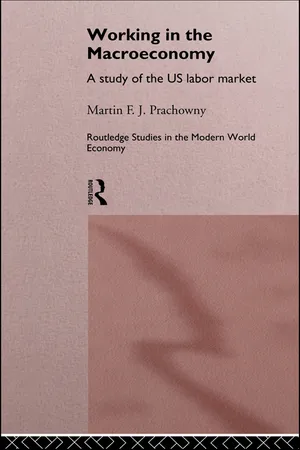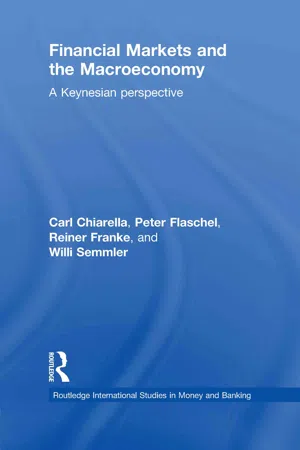Economics
IS Curve
The IS curve, or investment-savings curve, represents the relationship between real interest rates and real GDP where the goods market is in equilibrium. It shows the combinations of interest rates and GDP levels at which total spending equals total output. The IS curve is a key component of the IS-LM model, which is used to analyze the relationship between interest rates and output in the economy.
Written by Perlego with AI-assistance
Related key terms
Related key terms
1 of 4
Related key terms
1 of 3
8 Key excerpts on "IS Curve"
- eBook - ePub
- Krish Bhaskar, David F. Murray(Authors)
- 2015(Publication Date)
- Routledge(Publisher)
0 , will bring the goods market to equilibrium. This procedure may be repeated for each value of real income to obtain corresponding values of interest rate which will ensure equality of savings and investment. The line joining these pairs of values is the IS Curve and it is defined as the locus of combinations of real income and interest rate which will bring the goods market to equilibrium. Mathematically the IS Curve is simply the solution of equation 5.3 for R in terms of Y.The possibility that investment might be interest inelastic during periods of severe depression was mentioned earlier and it is important at this stage to consider the implications of this for the IS Curve. The derivation is shown in Figure 5.2 and it can be seen that in this case whatever the interest rate there is only one value of investment, I0 , which in turn means that there is only one value of savings, S0 , which will ensure an equilibrium in the goods market. Corresponding to this level of savings is real income, Y0 , so it is clear that any rate of interest combined with real income, Y0 , brings the goods market to equilibrium and the IS Curve in this situation is, therefore, a vertical line.Figure 5.2 Derivation of the IS Curve with interest inelastic investmentIntroduction of fiscal policy instruments
The introduction of government expenditure, G, and taxation, T, into the goods market is the next step. The first modification to incorporate is that savings must now be considered to be determined by disposable real income, Yd - eBook - ePub
- Martin F. J. Prachowny(Author)
- 1997(Publication Date)
- Routledge(Publisher)
Fig. 4–1 shows the IS curve with y measured on the horizontal axis and i, not i −e , on the vertical axis. Therefore, points on the IS curve represent constant aggregate demand only for a given rate of expected inflation. Its horizontal intercept is , its vertical intercept is , and its slope is −1/a1 . An increase in a0 shifts the IS curve upwards and to the right. An increase in e has the same effect and it should be noted carefully for later reference that the vertical displacement of the IS curve is exactly equal to the increase in eFigure 4–1 The IS curveIf points on the IS curve represent equilibrium in the market for goods and services, what can we say about points to the left or to the right of the IS curve? Consider a point such as B in Fig. 4–1 and compare it to point A which is on the IS curve. The point B has a higher interest rate than point A but the same income. Thus at B, saving and taxes are higher than investment plus government expenditures and therefore demand for the existing output is deficient. For this reason, all points to the right of the IS curve are designated as excesssupply points, requiring a fall in output to re-establish equilibrium at C. Excess supply is identified with involuntary inventory accumulation as output produced exceeds output demanded. Similarly, points to the left of the IS curve indicate excess demand since I>S. Excess demand is indicated by inventory reductions. From this argument it can be seen that the interest rate and income must move in opposite directions to keep involuntary inventory changes from appearing.4.1.2 The LM Curve
Whereas the IS curve deals with the market for goods and services as flows per period of time, the LM curve deals with asset markets as stocks at a point in time, but this is not an inconsistency in the model because flow equilibrium characterizes the former and stock equilibrium is essential to the latter. The LM - eBook - ePub
- Carl Chiarella, Peter Flaschel, Reiner Franke, Willi Semmler(Authors)
- 2009(Publication Date)
- Routledge(Publisher)
As q impacts positively on aggregate demand (while in the familiar textbook story the interest rate impacts negatively on Y d), this IS Curve is upward-sloping (rather than downward-sloping, when Y d depends on i). In addition, if q is held constant, then all non-equilibrium points are attracted by the IS Curve. These features are illustrated in Figure 2.4. Note that the IS Curve must cut the horizontal axis at a positive value, since the autonomous term in the aggregate demand function has been assumed as positive (representing basically the in”uence of “scal policy on aggregate demand). The IS Curve will shift to the right if”scal policy is expansionary and it will be steeper with smaller a y, the value of the marginal propensity to spend. Figure 2.4 The IS Curve (representing goods market equilibrium). 2.3.3 The LM Curve: q̇ = 0 In analogy to the treatment in the previous subsection, the second law of motion may be set to rest. This means that the stock market is in temporary equilibrium… in conjunction with money market equilibrium, which by (2.2) and i(Y) entering (2.8) is presupposed anyway. Although i (Y) was said to derive from a familiar LM condition, it will be convenient from now on to call the locus of pairs (Y, q) giving rise to (2.8) = 0 an LM curve. We stress that the LM curve of this chapter represents money market and stock market equilibrium and is thus more complex than the usual LM curve of the textbook literature (and in particular, not always positively sloped as in the case of the simple money market LM curve, see below). ThIS Curve, however, is unstable. Suppose share prices and, thus, Tobin•s q are so high that i (Y) q – r (Y) > 0, which says that the short-term interest rate i exceeds the direct returns r p K from holding equities when these are related to the value of shares (this rate of return being given by rpK/p e E = r/q). In this situation share prices are driven up even higher, according to q̇ > 0 in (2.8) - eBook - ePub
- Friedrich A. Lutz(Author)
- 2017(Publication Date)
- Routledge(Publisher)
1 )). When income rises, more money will be required for transaction purposes and less is left for speculative purposes. Accordingly, the rate of interest must rise as income increases if the money market is to stay in equilibrium. The equilibrium interest rate and the equilibrium income are then determined by the intersection of these two curves.Fig. 19The MM -curve can be divided into three sections. Starting from the left, the first runs as far as point W 1 thus covering the horizontal part of the curve. The second reaches from W 1 to W 2 , covering the section of the MM -curve which is rising to the right. The third begins at W 2 and covers the vertical section of the curve. Let us first consider the middle section: here a rise (fall) of the marginal efficiency of investment or a fall (rise) in the propensity to save – which move the IS -curve towards the right (left) – raise (lower) income as well as the interest rate. In the case of a rise in the marginal efficiency of investment the adjustment process should be pictured as follows: the increase in the marginal efficiency leads to more investment which will be financed with money previously held for speculative purposes. The additional investment brings about a higher level of employment and thus also a larger income. The interest rate will rise. The new equilibrium will be reached when, out of the increased income, an amount is saved which is equal to the investment.Let us now assume that the IS -curve cuts the MM -curve in its initial horizontal segment. In that case a shift of the ZS -curve will obviously not affect the interest rate, provided that the point of intersection with the MM -curve remains on the horizontal segment of this latter curve. In this situation the interest rate is at its minimum level. If the IS - eBook - ePub
Prosperity and Public Spending (Routledge Revivals)
Transformational growth and the role of government
- Edward Nell(Author)
- 2009(Publication Date)
- Routledge(Publisher)
The value of the multiplier will now depend on the state’s welfare policy, as well as upon the real wage and the productivity of labor. Clearly a realistic theory will require still further extensions, but the principles upon which these should be based ought by now to be apparent.VI The Markets for Funds
In conventional theory, households make savings decisions, based on their income and the interest rate, while businesses make investment decisions, based on their sales receipts and the interest rate. The IS Curve is then defined as the locus of all combinations of income and the interest rate for which household saving equals business investment. This is then put together with the locus of all combinations of income and interest for which the supply and demand for money are equal, to determine overall macroeconomic equilibrium. The interest rate, then, functions as a neo-Classical ‘price’, helping to equate supply and demand, in two markets: for investible funds, and for money to hold.But when the theory of effective demand is based firmly on Classical-Marxian foundations, no such markets exist. Withdrawals as well as injections are determined on the business side of the social accounts. Households are purely passive; they simply pass along their wage income as consumption expenditure. There are no savings, and no saving decisions, by households; so there is no market in which the rate of interest could play the role of a price.11 The forces of productivity and thrift’, in the neo-Classical sense, are not there. The funds to underwrite investment are generated by employment, since employment, because it produces a surplus over the real wage bill, creates the ‘withdrawals’ or ‘leakages’ required.Not only is there no loanable funds market here, there is no supply and demand market for money either. When employment increases, businesses draw on their lines of credit, previously established to provide the working capital necessary to operate their productive capacity. Using this credit they pay the higher wage bill. The wage payments are deposited, then spent and redeposited as sales proceeds. Since the wage bill in the investment goods sector generates the profit in consumer goods, it provides the finance for that sector’s purchases of investment goods, while the investment goods sector’s own purchases of its products can be financed by borrowing against investment goods inventory. So bank deposits and hence ‘the money supply’ automatically increase as employment increases. Note that this is consistent with the banking system being fully ‘loaned up’ both at low levels and at high levels of activity. At low levels deposits are low, but so is the volume of loans. Established lines of credit lie unused. But when they are drawn on, wage payments and consumption (and therefore bank deposits) rise. Loans and deposits rise and fall together reflecting changes in economic activity. The supply of money for transactions—current deposits—adapts to the demand for it, once we grant that the banking system will provide business with credit lines equal to the working capital required to operate existing productive capacity.12 - eBook - ePub
- Shahdad Naghshpour(Author)
- 2014(Publication Date)
- Business Expert Press(Publisher)
Fiscal policy can be implemented through changes in government expenditures and taxes. Changes in taxes can be implemented in several ways. Different types of taxes at local, state, and federal levels consist of excise, sales, property, and income, to name a few. Taxes can set at a fixed amount, such as an import tax per item, regardless of its value or the income of the importer; proportionate, such as sales tax; based on value, such as property tax; or multirate, such as income tax. Taxes that are not a function of income cause shifts in aggregate demand while taxes that are a function of income have ripple effects in the economy. This is because taxes accrue with each round of change in income that is generated from changes in fiscal policy. Taxes that affect the wealthy, such as property taxes, also affect aggregate demand, for two reasons. First, they affect income because of tax payments. Second, they affect wealth; therefore, they have an inverse effect on consumption. A property tax increase reduces wealth, and thus, reduces consumption because of a wealth effect. For a given level of income, a wealthier person will have greater consumption than someone with less wealth. For simplicity, typical IS Curves are created based on a flat rate tax system. The type of tax and its formation, for example progressive taxes, affects the degree to which people at various income levels bear the tax burden. For example, a tax levied on the consumption of cigarettes affects both smokers and cigarette producers based on the price elasticity of demand for cigarettes.Government expenditures can be in the form of consumption, such as the purchase of an automobile for official use; investment, such as building a plant to produce nuclear missiles; or, for the purpose of social welfare, such as transfer payments. Some government expenditures are welcome in general, such as the establishment of national defense, while others create more debate, such as transfer payments. The amount of investment by the United States government has been declining since the 1970s and is currently averaging less than 1.5% of the GDP of the country. An increase in government expenditure is expansionary and stimulates the economy regardless of its form or purpose, while an increase in taxes is contractionary regardless of its form or purpose.An expansionary fiscal policy, in the form of increased government expenditures or decreased taxes, shifts aggregate expenditures upward causing an upward shift in IS Curve. Assuming there is an idle capacity in the economy and that an accommodative monetary policy is in place, the result is an increase in aggregate output until the full employment level of output is restored, and the idle capacity of firms is used up. Idle capacity means there is unemployment in the labor and capital markets. An accommodating monetary policy means that the supply of money is increased, rather than kept constant or decreased.Pigou EffectPigou might be considered the last relevant classical economist. Pigou argues that in cases where prices and wages are not rigid downward the Keynesian model would result in full employment equilibrium.1 This is in contrast to Keynes’s claim of equilibrium with persistent unemployment because, as Pigou points out, Keynes ignored the wealth effect. The following discussion utilizes Figure 5.2 , which was used earlier to discuss the liquidity trap in Chapters 3 and 5 - eBook - ePub
The Macroeconomic Environment of Business
Core Concepts and Curious Connections
- Maurice D Levi(Author)
- 2014(Publication Date)
- WSPC(Publisher)
Fig. 7.7. The market interest rate.The market interest rate balances loanable funds demand with loanable funds supply. This is not the equilibrium rate if at that rate savings, S, are not equal to investment, I.The market interest rate equates the supply of and demand for loanable funds.As well as showing LS and LD , Fig. 7.7 also shows the curves behind the supply of and demand for loanable funds. Because LS is the horizontal sum of ΔMS and S, and LD is the horizontal sum of ΔMD and I, i.e., LS = ΔMS + S and LD = ΔMD + I, at the market interest rate:We see that there is no requirement at the market interest rate for savings to be equal to investment, because the change in the supply of and demand for money may not be equal. For example, if ΔMS is larger than ΔMD , then Eq. (7.1) tells us that at the market interest rate, I exceeds S. Indeed, the extent to which the change in money supply exceeds the change in money demand is equal to the extent investment exceeds savings. This is the situation shown in Fig. 7.7 . From examination of the figure, we can see that at the market interest rate the excess of ΔMS over ΔMD is equal to the excess of I over S.With it being possible for S to differ from I at rM the market interest rate is not an equilibrium rate. This is because if, e.g., I exceeds S at rM ,so that injections into the circular flow of income exceeds withdrawals, then ceteris paribus, the GDP will increase to a higher level. The increase in GDP will shift the savings curve to the right until S = I.6 With S = I, and also with the market interest rate such that LS = LD , i.e.,it must also be the case that ΔMS = ΔMD . This rate of interest at which S = I and ΔMS = ΔMD is called the equilibrium interest rate.The equilibrium interest rate equates savings and investment. Over time, the market interest rate moves towards the equilibrium interest rate via adjustments in GDP - eBook - ePub
- Raghbendra Jha(Author)
- 2003(Publication Date)
- Routledge(Publisher)
In most developing countries imports and domestic goods are very poor substitutes. For LDCs that have embarked on a course of import substitution and have completed most of it, import consists largely of non-competitive imported inputs. We suppose that imports are a fixed proportion of domestic output.It should also be pointed out that many LDC governments derive substantial revenues from ad valorem taxes on imports (τm ). We shall also model a tax on exports (τx )—which may actually be a subsidy τx < 0. Further, the trade sector is a very important part of national accounts and many significant macroeconomic problems of developing countries have their genesis in a large deficit in their current accounts.We write net exports (NX) as(8.16)where X is the value of exports in foreign currency. We can write the goods market equilibrium condition as(8.17)The equilibrium relation between i and Y from the above equation will be the IS schedule. This schedule will have a negative slope in the (i, Y) plane for fixed values of other variables. This IS schedule is likely to be quite steep. A major reason for this is the low interest elasticity of investment demand. However, as Leff and Sato (1980) argue, the IS Curve may not be too steep on two counts: first, the large value of marginal propensity to consume in developing countries and, second, the high income elasticity of investment demand.An increase in government expenditure will shift the IS Curve outwards. An increase in τx or τm will reduce the value of net exports in domestic currency for a given foreign currency balance, thus shifting the IS Curve inwards. This is concentrated to some extent if export supply or import demand are price elastic.When there is a devaluation of the real exchange rate (e/P) the terms of trade are adversely affected and investment declines because the cost of intermediate inputs rises. From our study of the Marshall-Lerner condition in Chapter 6 we know that if B is the initial trade balance in domestic currency, ηxs is the export supply elasticity, εMD is the (absolute value) of the import demand elasticity and Z
Index pages curate the most relevant extracts from our library of academic textbooks. They’ve been created using an in-house natural language model (NLM), each adding context and meaning to key research topics.
Explore more topic indexes
Explore more topic indexes
1 of 6
Explore more topic indexes
1 of 4







